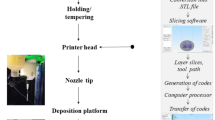Abstract
Three-dimensional (3D) printing of food is an emerging industry, where continuous rigorous research is in progress for printing the new textured food through various food inks developed. However, food printing is a part of the 3D printing industry, but making a successful 3D printed food product is still a wide dimensional challenge. The food products which are made have a particular shelf life, to which its quality is best suited for consuming them. After this shelf life, the quality starts deteriorating, to prevent certain kinds of practical steps are necessary.
The chapter contains brief details about the spoilage of 3D printed food and their prevention from their printing to their shelf life. The prevention is in terms of printing, storing, packaging, and dispensing. A variety of techniques are already developed and used for conventionally made food items.
Access this chapter
Tax calculation will be finalised at checkout
Purchases are for personal use only
Similar content being viewed by others
Abbreviations
- 3D:
-
3-Dimensional
- C6H5COOH:
-
Benzoic acid
- C6H8O2:
-
Sorbic acid
- CO:
-
Carbon monoxide
- CO2:
-
Carbon dioxide
- HDPE:
-
High-density polyethylene
- LDPE:
-
Low-density polyethylene
- LLDPE:
-
Linear low-density polyethylene
- MDPE:
-
Medium density polyethylene
- N2:
-
Nitrogen
- SO2:
-
Sulphur dioxide
References
Makroo HA, Naqash F, Fayaz S (2021) Antimicrobial compounds to improve foods’ shelf life. Food Waste Recover:461–482. https://doi.org/10.1016/B978-0-12-820563-1.00020-2
Clelia A (2017) Food spoilage and food safety: is there a link? Microbiol Qual Food Foodborne Spoilers:283–300. https://doi.org/10.1016/B978-0-08-100502-6.00015-7
Ghazal AF, Zhang M, Bhandari B, Chen H (2021) Investigation on spontaneous 4D changes in color and flavor of healthy 3D printed food materials over time in response to external or internal pH stimulus. Food Res Int 142:110215. https://doi.org/10.1016/J.FOODRES.2021.110215
Richardson T, Finley JW (eds) (1985) Chemical changes in food during processing. Springer. https://doi.org/10.1007/978-1-4613-2265-8
Lianou A, Panagou EZ, Nychas GJE (2016) Microbiological spoilage of foods and beverages. Stab Shelf Life Food:3–42. https://doi.org/10.1016/B978-0-08-100435-7.00001-0
Petruzzi L, Corbo MR, Sinigaglia M, Bevilacqua A (2017) Microbial spoilage of foods: fundamentals. Microbiol Qual Food Foodborne Spoilers:1–21. https://doi.org/10.1016/B978-0-08-100502-6.00002-9
Sousa Gallagher MJ, Mahajan PV, Yan Z (2011) Modelling chemical and physical deterioration of foods and beverages. Food Beverage Stab Shelf Life:459–481. https://doi.org/10.1533/9780857092540.2.459
Stiles ME (1991) Modified atmosphere packaging of meat, poultry and their products. Modif Atmos Packag Food:118–147. https://doi.org/10.1007/978-1-4615-2117-4_5
Sun XD, Holley RA (2012) Antimicrobial and antioxidative strategies to reduce pathogens and extend the shelf life of fresh red meats. Compr Rev Food Sci Food Saf 11(4):340–354. https://doi.org/10.1111/J.1541-4337.2012.00188.X
Speranza B, Corbo MR, Conte A, Sinigaglia M, Del Nobile MA (2009) Microbiological and sensorial quality assessment of ready-to-cook seafood products packaged under modified atmosphere. J Food Sci 74(9):M473–M478. https://doi.org/10.1111/J.1750-3841.2009.01369.X
Suppakul P, Miltz J, Sonneveld K, Bigger SW (2003) Active packaging technologies with an emphasis on antimicrobial packaging and its applications. J Food Sci 68(2):408–420. https://doi.org/10.1111/J.1365-2621.2003.TB05687.X
Author information
Authors and Affiliations
Editor information
Editors and Affiliations
Rights and permissions
Copyright information
© 2022 The Author(s), under exclusive license to Springer Nature Singapore Pte Ltd.
About this chapter
Cite this chapter
Singh, H. (2022). Prevention of Three-Dimensional (3D) Printed Food from Spoilage. In: Sandhu, K., Singh, S. (eds) Food Printing: 3D Printing in Food Industry. Springer, Singapore. https://doi.org/10.1007/978-981-16-8121-9_10
Download citation
DOI: https://doi.org/10.1007/978-981-16-8121-9_10
Published:
Publisher Name: Springer, Singapore
Print ISBN: 978-981-16-8120-2
Online ISBN: 978-981-16-8121-9
eBook Packages: Biomedical and Life SciencesBiomedical and Life Sciences (R0)




